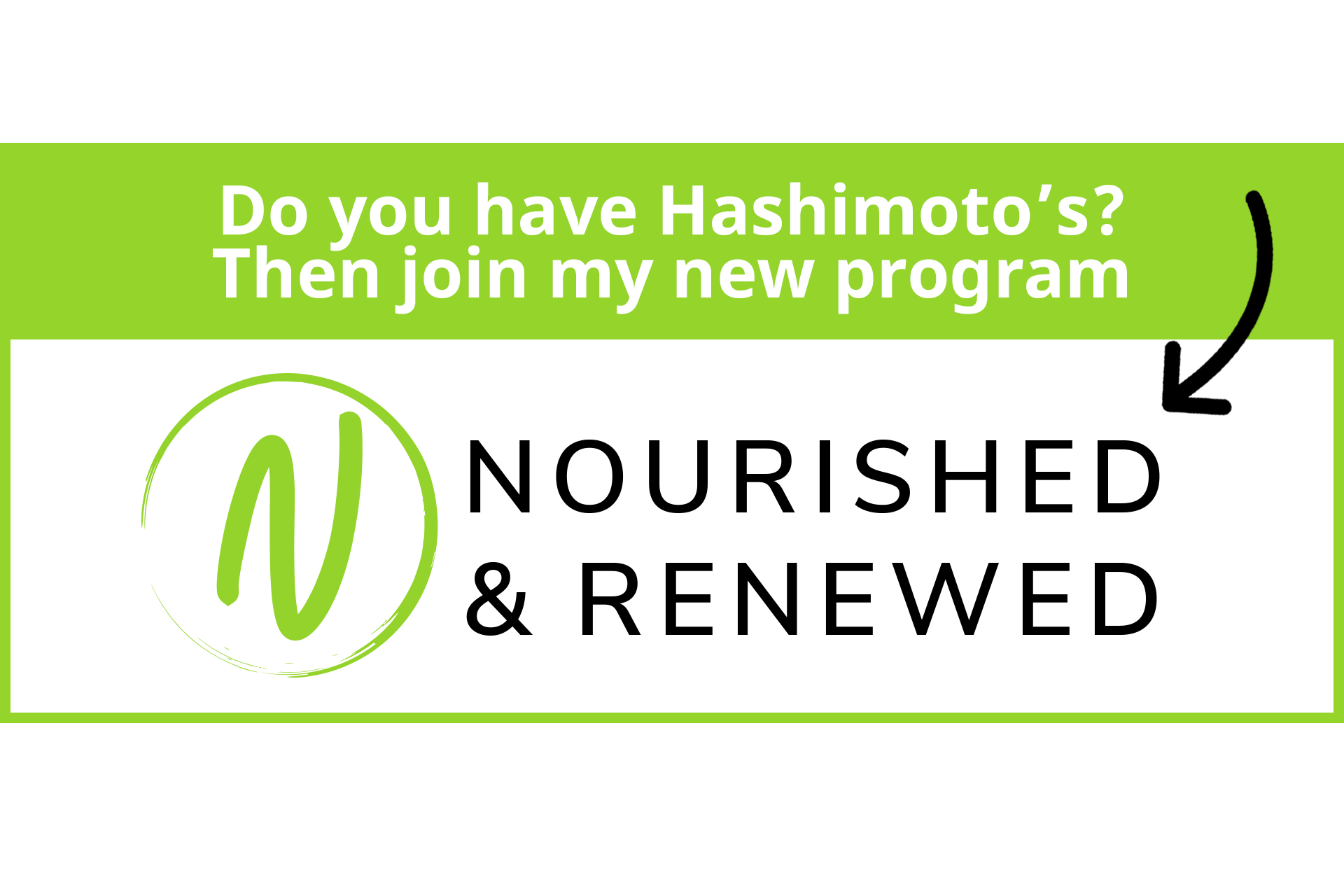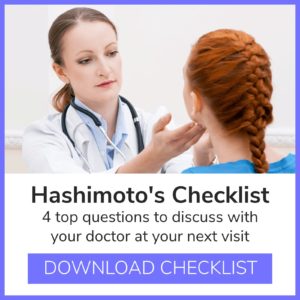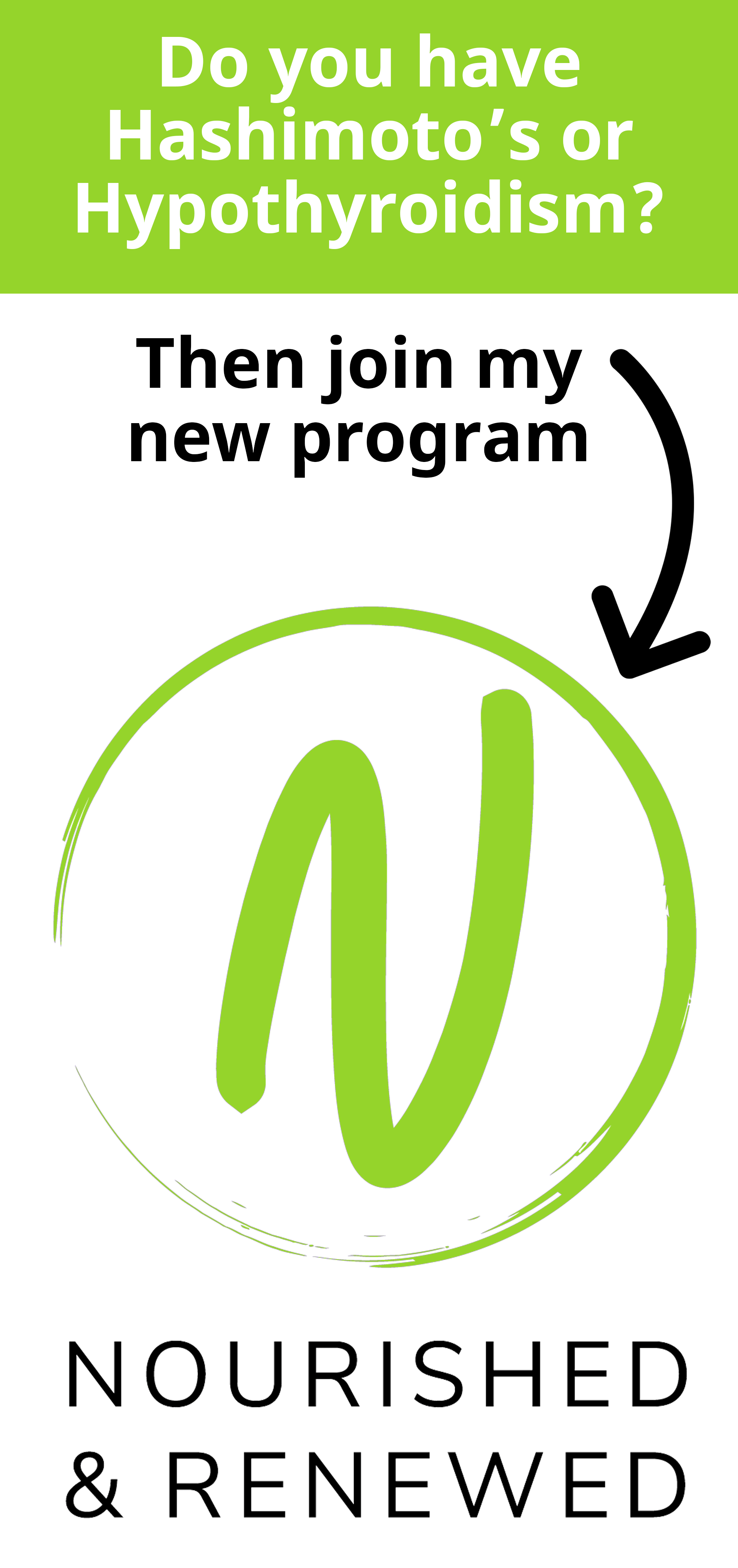Approximately 5% of women develop postpartum thyroiditis after giving birth.
Women with a personal or family history of autoimmune or thyroid disease are more likely to develop the condition.
When my son, Clay, was born, I went through postpartum thyroiditis (PPT). I didn’t know what was happening to me and I used my own experience to study PPT in depth.
I knew I would encounter other women with a similar story. And, I wanted to be able to help them.
Tired, Wired and Falling Apart After Childbirth
My client “Bella” came to me when her baby boy was just 4 months old.
Her baby boy coo’ed and gurgled happily while we talked during her new client intake session.
While Bella wept.
She felt like she was literally falling apart.
She had lost:
- so much of her hair
- too much weight way too fast
- and countless hours of sleep in the four months since giving birth
She was anxious, edgy and of course, weepy.
Taking a look at her laboratory reports from her obstetrician-gynecologist (OB/GYN), and her medical history, it was clear to me that Bella was in the midst of a postpartum thyroiditis (PPT) crisis. She was hyperthyroid and her thyroid gland was in overdrive.
Bella is not the only one who goes through this kind of medical situation following childbirth.

Postnatal Period: A Window for Autoimmunity
For weeks, even months, after giving birth a woman's body is going through enormous changes.
Consider this: a pregnant woman makes as much estrogen in 40 weeks of pregnancy as a non-pregnant woman makes in her entire lifetime.
(WOW! That statistic blows my mind each and every time I hear it or say it!)
It makes sense that the decline in pregnancy hormones shortly after giving birth is a bit of a shock to the system.
All systems are in full-on crisis mode to help the mother detoxify and excrete this excess estrogen in the weeks and months following pregnancy.
The liver, digestive system, kidneys, adrenal glands and the thyroid gland all work over-time to support the health of the mother.
Therefore, the postpartum period is a time when her body can easily get sick.
And, the postpartum period is also a time when the immune system can go awry and autoimmunity can result.
If there is a personal or family history of autoimmunity, the hormonal changes of pregnancy can be a trigger for autoimmunity after childbirth.
And, given that autoimmune thyroid disease affects over 14 million people, the statistics about PPT really should not come as too much of a surprise,
Many times, a woman is told that she has subclinical autoimmunity (meaning she is symptomatic, but the labs are still “normal”) prior to pregnancy.
It is after the birth, that a woman is often most vulnerable to a full-scale autoimmune attack.
Pitfalls in the Postpartum Period
Giving birth and becoming a new mother is one of the most exhausting physical and emotional experiences for a woman.
If you have been on this journey, then you know what I am talking about.
But, maybe you are newly pregnant and are wondering what the future holds.
Well, I can tell you from my own experiences, the weeks after giving birth are wonderful and worrisome all at once.
Most importantly, the new life you have brought in to the world will literally change your life forever in a million incredible ways.
Immediately following the rollercoaster ride of labor and birth, a new mother is faced with so many changes and challenges.
Unfortunately, as is the norm in our culture today, the responsibility of taking care of the baby leaves little time for the new mom to rest and recover.
Ages ago (like, literally hundreds of years ago), there were different processes in place to allow a mother to heal and nourish herself before launching in to full-on motherhood.
Ever since the dawn of the modern industrialized era, a woman has had MUCH LESS SUPPORT with child-bearing and children-rearing.
She may have only a few weeks of paid leave from her job, her partner maybe even less. Help from family, friends, neighbors, etc. is also often short-lived.
Even support from medical providers is limited to postpartum check-ups, namely to give the green light to a woman when she can resume exercise and intercourse at around six weeks.

Other Complications Besides Postpartum Thyroiditis
There are other complications which can arise after giving birth if the new mother is not taking care of herself.
- Postpartum hemorrhage
- Postpartum depression
- Adrenal fatigue
- Iron-deficiency anemia
- Urinary and vaginal tract infections
- Hemorrhoids
- Skin changes like acne and rashes
- Hair loss
Many postpartum issues have a certain amount of “taboo” around them, leaving many women fearful to talk openly about the challenges they face for fear of being seen as weak.
Super-Woman mentality really kicks in during the postpartum period.

Post-Pregnancy: Trying to Do it All?
Joining social moms groups, taking baby along to classes and outings with older children, going back to work before you and baby are ready, etc. – sound familiar?
A new mom gets no safety rudders from modern society to tell her it is in fact OK (and necessary) to slow down.
Sure, I understand (and relate to) the fact that nearly every woman is ready to get back in to her old jeans and feel like her pre-pregnancy self.
Going on a “diet” for weight loss is a common subject among new mothers. And, doing so too soon could increase the chance of having complications and weaken the body’s constitution, perhaps even resulting in long-term health problems.
More importantly, many moms ultimately find themselves “too busy” to simply feed themselves the healthy, nutrient-dense foods they need to be the very best versions of themselves.
Poor nutrition during the postpartum period compromises the new mother’s ability to produce adequate breast milk for her baby. This can become a vicious and stressful cycle for both mother and baby.
Simply put, being over-worked, under-slept, facing the emotional challenges of parenting and possible malnutrition to boot, women’s needs as mothers are put last.
That sets the stage for postpartum thyroiditis.
Common Symptoms of Postpartum Thyroiditis
In my nutrition practice, about 50% of the women clients who come in with thyroid disease report that their complaints/symptoms/diagnosis arose shortly after giving birth.
During postpartum thyroiditis, a woman might experience two phases. I am one who experienced both.
Inflammation
The inflammation phase constitutes an abundance of thyroid hormone release from the gland in to the body.
And, this overproduction of thyroid hormones might first cause signs and symptoms similar to those of an overactive thyroid (hyperthyroidism), such as:
- Anxiety
- Irritability
- Rapid heartbeat or palpitations
- Unexplained weight loss
- Increased sensitivity to heat
- Fatigue
- Tremor
- Insomnia
- Hair loss
These signs and symptoms typically occur one to four months after delivery and may last from between one to three months.
Thyroid Cells Dysfunction
Later, as thyroid cells become impaired and dysfunctional, signs and symptoms of underactive thyroid (hypothyroidism) might develop, including:
- Lack of energy
- Increased sensitivity to cold
- Increased susceptibility to infection
- Constipation
- Dry skin
- Difficulty concentrating/brain fog
- Aches and pains
- Hair loss
Hypothyroid signs and symptoms typically occur four to eight months after delivery and can last from nine to 12 months, or indefinitely.

Causes of Postpartum Thyroiditis
Even though though I just pointed out some of the many factors at play, the exact cause of PPT isn't clear.
We do know that women who develop PPT often have high concentrations of anti-thyroid antibodies either before, early in pregnancy or after childbirth.
As a result, it's believed that women who develop PPT likely have an underlying autoimmune thyroid condition that flares after childbirth.
There are many possible triggers and risk factors for PPT:
- fluctuations in immune function
- normal pregnancy hormonal changes
- complications in pregnancy
- stressors in pregnancy
- illness in pregnancy
- food intolerances in pregnancy
- poor diet in pregnancy
- history of smoking, alcohol and drug use
- personal and/or family history of thyroid disease
For most women who develop PPT, thyroid function eventually returns to normal - typically within 12 to 18 months from the start of symptoms. However, some women who experience postpartum thyroiditis don't recover from the hypothyroid phase.
These women will go on to have a lifelong diagnosis of Hashimoto’s disease.
Hashimoto’s and Postpartum Thyroiditis
Women with previously diagnosed and treated Hashimoto’s will most likely have some changes to their thyroid hormone levels and medications, both during and following pregnancy.
There is wide variability regarding the medication dose changes necessary to maintain a normal TSH throughout pregnancy.
Some women need only 10%–20% increased dosing, while others may require as much as an 80% increase.
Therefore, if you are pregnant with Hashimoto’s, at a minimum your TSH levels should be monitored approximately every 4 weeks during the first half of pregnancy, and possibly weekly for the second half.
It is not at all uncommon for dose adjustments to be made multiple times during pregnancy.
Please hear this: After pregnancy, a woman with Hashimoto’s needs to have her levels checked again, right away.
I suggest testing for a TSH level one to three days after giving birth, and a full thyroid panel no later than 6 weeks after giving birth.
Not all PPT is caught early enough.
Often a woman’s symptoms are too closely related to the other physical and mental changes brought on by having a newborn (anxiety, fatigue, weight issues, brain fog, etc.). Some providers will dismiss these symptoms as being “normal” for a new mother.
If you have Hashimoto’s you need to clearly advocate for yourself and tell your provider you want more careful monitoring both during the pregnancy and immediately after.
Not all women with Hashimoto’s will develop postpartum thyroiditis
From my own experience, I can say that having Hashimoto’s was obviously the reason that I had PPT after giving birth to my son.
I was unaware that having Hashimoto’s meant possible complications for me after pregnancy. And, my providers were less than concerned about my off-the-wall symptoms.
But, I was concerned. Very concerned.
First I was severely hyperthyroid for nearly 6 weeks. I wanted to jump out of my skin. I stopped my medication altogether (I do not recommend doing that without guidance from your provider). And, my symptoms improved but didn’t go away.
Then, I crashed and went very hypothyroid for at least the following 9 months. My Synthroid dosage was then prescribed at an all-time high.
Despite that, my symptoms were nearly debilitating some days.
Finally, around my son’s first birthday, I knew the PPT has passed and I was back to a normal (for me) dosage of Synthroid. My symptoms were gone.

Testing & Treatment for Postpartum Thyroiditis
Tests used to diagnose postpartum thyroiditis depend on the phase of the disease. A blood test can often tell if you have an overactive or underactive thyroid.
Treatment will depend on your symptoms, age, and general health. It will also depend on how severe the condition is.
Treatment depends on the phase of the disease and your symptoms:
- Hyperthyroid: If you have major symptoms of hyperthyroidism, your provider will often prescribe beta blockers, antithyroid agents like methimazole (Tapazole®) or in rare instances propylthiouracil (PTU). These medicines slow down your heart rate and ease symptoms of inflammation.
- Hypothyroid: If you have major symptoms of hypothyroidism, your provider will prescribe thyroid hormone replacement such as Synthroid, or the generic Levothyroxine.
The bottom line is that you should have regular thyroid tests after giving birth if you have already been diagnosed with Hashimoto’s, or even if you haven’t but you are symptomatic.
Finding a qualified, caring and experienced practitioner to help manage your PPT is key. I didn’t have one at the time (I do now!) and I know it could have made all the difference in the world.
The good news is, your thyroid may be working normally within 12 to 18 months after the symptoms start. If so, you may be able to stop treatment.
Postpartum Thyroiditis and Your Baby
Sure, now you know that having PPT is wrecking some amount of havoc on your health and your life.
You might also be worried that having PPT might be affecting your baby. It’s a scary thought.
This new life you just brought in to the world might be suffering from something that is going on medically with your body.
Hang on, though, Mamma. Don’t let scary thoughts confuse things.
You are doing an amazing job with your baby!
Your baby is healthy and fine!
PPT is a maternal illness. Babies cannot develop thyroid disease at the time that the mother is symptomatic.
Still, I know that when my son, Clay, was a baby, I worried.
I worried that my anxiousness from the hyperthyroid state was rubbing off on him and making him colicky.
I also struggled with producing enough breast milk.
And, despite pumping, lactation consultants, every herbal remedy, and a conscientious breastfeeding diet, I needed to supplement Clay at around 8 weeks.
Oh my goodness, what a difference that made for both of us.
I mean, being hyperthyroid, feeling anxious, not producing enough milk for my baby, baby is crying - it only served to increase stress in both of us even more.
Even my husband was stressed out.

Supplementing breast milk with baby formula
So, supplementing Clay with homemade baby formula broke that cycle for us.
Breastfeeding for some women is challenging enough. Throw in PPT and it can be downright daunting.
Also a concern for many women with PPT is whether the thyroid medication you have been prescribed is safe for baby.
I encourage you to speak to your provider about all the medication options available to you based on your individual needs: synthetic (like Synthroid), natural dessicated thyroid (like Armour), compounded medications, T3-only medications (like Cytomel), beta-blockers and steroids.
Small amounts of levothyroxine (the medicine for hypothyroidism) do pass through breast milk. But most medical doctors agree that levothyroxine will not cause problems for your baby.
Also, please inform your baby’s pediatrician about your diagnosis with PPT. They can be a wonderful, supportive resource to help you through this time.
Recommended Nutrition for Postpartum Thyroiditis
Good nutrition is needed most to help the body recover and cope with the many new changes.
The body will respond like a sponge and absorb whatever natural nutrients it can get – it is important for new moms to take advantage of this time to repair, rejuvenate and nourish the body through healing foods.
If you haven’t already begun so during pregnancy, a nutrient-dense and whole-foods based eating program ought to be implemented within the first few days after giving birth.
Cold drinks and cold foods should be restricted as much as possible because they weaken the digestive system and may cause stomach pain.
Cold food and drink affects digestion, metabolism and healing and may contribute to a weakened immune system.
The following specific nutrients are supportive of overall health and healing after having a baby.
But they are also very important in preventing PPT:
Calcium:
Calcium helps with nerve function and blood clotting, which are very important as you heal from birth.
If you are a breastfeeding mom you will need additional calcium. This is because much of it is drained out of your system through your breast milk for your baby’s developing skeletal system.
Calcium is available in dairy products (choose organic), dark leafy green vegetables, and is also available in supplement form.
Iron:
Iron is an essential part of your red blood cells and their ability to carry and use oxygen in the cells. Without enough iron, you may find yourself fatigued, weak and at a higher risk for infection.
If you are taking iron supplements, adding foods rich in Vitamin C like tomatoes, oranges, baked potatoes, and steamed broccoli can help your body better absorb the iron.
If you want to increase iron through diet, you’ll want to consider eating more lean red meat, spinach, beans, and egg yolks.
Zinc:
Zinc helps support a healthy immune system. It also increases cell production, wound healing, and tissue growth and repair, which are vital as you recover from birth.
Good zinc-rich foods are red meat, oysters, poultry, legumes, eggs, fish, seafood, whole grain products, black-eyed peas, and miso (fermented soybean paste).

Protein:
Eating enough protein will help you rebuild muscle in your body postpartum. Chicken, fish, beef, nuts and eggs are all high in protein.
Water:
Choose liquids like water, fresh juice and herbal tea instead of coffee or soda. Drink at least eight to ten glasses of pure water a day. This will help with milk production and also prevent dehydration, constipation, and clogged milk ducts.
Drinking a glass of water each time you nurse will ensure that you are getting plenty of fluid throughout the day.
Black Wood-ear and Chicken Soup to help a new mother recover from childbirth
I love this very helpful and healthful soup recipe for new mothers.
Give this recipe to your postpartum doula, neighbor or a grandparent to cook and serve immediately when you and baby come home from the hospital. Or, any time after giving birth, really. There are many benefits at any stage in the postpartum period.
This excellent soup is based on Eastern nutritional philosophy and is designed to help a new mother recover from childbirth. Its ingredients are believed to help tonify the blood and the stomach.
This soup helps to clear blockages in the digestive tract and promotes normal flow of discharge from the reproductive organs.
It may relieve inflammation in the lower pelvis and abdomen. It is delicious, warming and comforting to the new mother.
Ingredients:
- 1 cup of black wood-ear mushrooms (found in health food stores or Asian markets)
- ¼ cup rice wine
- 1 large chicken breast, bone and skin still intact
- 2 T fresh ginger root chopped
- 5 cups spring water
- sea salt and black pepper to taste
Preparation:
- Soak wood-ear mushrooms in warm water for 30 minutes or until soft, rinse and cut into thin strips.
- Put chicken breast in boiling water for 5 minutes to poach, then remove and drain off water.
- Put all ingredients in a pot with adequate water (about 5 cups) and simmer on low for 30 minutes.
- Add rice wine after 30 minutes of cooking and continue to simmer, until the soup reduces to about 3 cups; chicken will begin to fall off the bone and become very tender.
- Season with sea salt, pepper, and even a pinch of cayenne or tamari to serve.
- Eat all ingredients with soup.
- May be served over steamed brown rice.
- Eat approximately 1 cup of soup with a meal once a day for five days to receive maximum health benefits.

Seek Help and Know You are Not Alone
For me personally, the worst aspects of PPT were:
- feeling like I was all alone in my illness and I could not tell anyone what I was going through
- concerns about being judged about supplementing my baby with formula
- being a nutritionist and having a “problem” after giving birth
- not having a good doctor to help me through testing and treatment
- not knowing when the horrible symptoms would subside
- not knowing what each day would bring as far as energy, mood and happiness
- concern that I would have PPT again with subsequent babies (I did not, thankfully)
That was heavy stuff, ladies.
I sigh.
Remembering that time makes me a little sad and also makes me realize how much of it has shaped my life and career.
Really, one of the main reasons for starting a holistic family nutrition practice is because I had postpartum thyroiditis after giving birth.
I previously had other plans for my niche in the nutrition field.
But, everything I learned through having PPT (and also learning about homemade baby formula) was a real game changer for me.
I researched and applied so many nutrition principals (again) to my own health and healing during that time.
Thankfully, due to the abundance of patient advocacy and support groups available on the Internet, I ultimately realized I was not alone.
So, I see you. And, I know you.
I was you.
PPT is a real challenge but you will get through it.
I am here to help.



